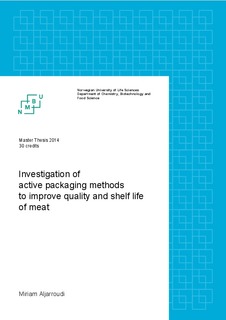| dc.description.abstract | It is well known that Active packaging, like the use of modified atmosphere, gives an improved quality on fresh food products and extended shelf life. The need of active packaging is partly due to the increasing demand of food that is minimally processed, is easily preserved, fresh and with a long shelf life. In the recent years, it has also been a greater focus on limiting the use of preservatives in food. These criteria present challenges for food safety and food quality, and driving a search for innovative ways to inhibit microbial growth in food, maintaining quality, freshness and safety. Antimicrobial packaging is a promising form of active food packaging, in particular for meat products.
The intention of this study was to investigate the effect of a specific antimicrobial film as packaging material in combination with modified atmosphere packaging (MAP). And, also compare this to the APET/PE packaging with MAP, on quality and shelf life of beef loin steak. The effect of the packaging methods, combination of gas atmosphere and packaging material, was evaluated by monitoring the gas content, color, drip loss, pH and microbial growth on beef loin steaks. Samples were examined after 9, 16, 22, 27 and 30 days of storage at 4 °C.
Slices of beef loin steaks were packed in two different materials, one antimicrobial and one consisting APET/PE. Two different packing methods were used for both materials; vacuum and modified atmosphere packaging, with two different gas atmospheres were used, 60% CO2/ 40% N2 and 75% O2/ 25% CO2.
The results show that the antimicrobial packaging had no better inhibition of bacterial growth compared to the modified atmosphere packaging. Packing methods however, had a greater effect on the inhibition of bacterial growth. The storage stability of the vacuum packed meat was relatively for 22-25 days, and MAP consisting of 60 % CO2/ 40% N2 about 30 days. When it comes to the storage capability of MAP, high oxygen consisting of 75 % O2/ 25 % CO2, it was also about 30 days.
But the bacterial growth was unexpected, extremely low. This seems strange considering that meat stored in high oxygen, usually turns bad long before meat packed in CO2. The values for color, liquid loss, and the pH of the meat in the two package materials were nearly identical, but the a* value (redness) was higher, and the fluid loss was slightly lower for the meat in antimicrobial packaging.
The main conclusion is that modified atmosphere packaging with CO2/N2 in combination with APET/PE packaging had the best effect in increasing the quality and durability, considering that high oxygen eventually will result in a rancid flavor of the meat. While the antimicrobial packaging had no generating effect of inhibiting bacterial growth, but resulted in lower drip loss and higher a * - and b * values in relation to the meat with APET/PE packaging. | nb_NO |
